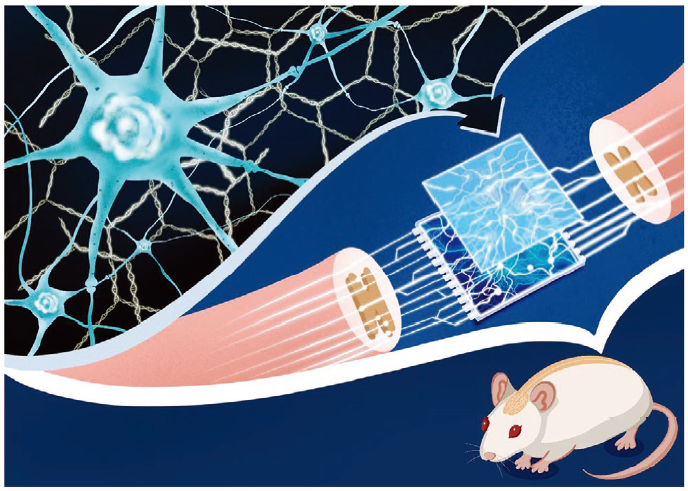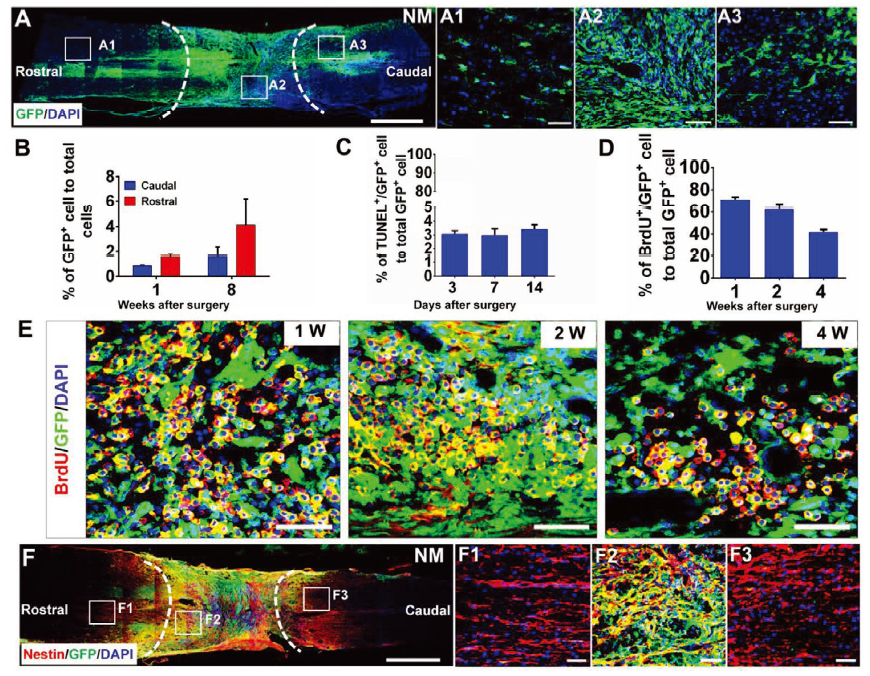Liu Dongsheng et al. AM of Tsinghua University: highly permeable DNA supramolecular hydrogel to enhance the therapeutic effect of stem cells
For mammals, it is impossible to regenerate naturally after severe spinal cord injury. Transplantation of stem cells into injured sites is considered to be a promising method of artificial repair, but this method relies heavily on the microenvironmental support provided by sites and delivery materials. Although the mechanical properties, biocompatibility and biodegradability of delivery materials have been widely studied and explored, there is almost no complete and in-depth understanding of material permeability.
Songbai Cui of Capital Medical University, Yan Hao of Arizona State University and Liu Dongsheng of Tsinghua University jointly designed a kind of DNA hydrogel with extremely high permeability, which can successfully repair the spinal cord gap at the level of 2 mm in the rat model. The treated rats can restore the basic hindlimb function, and the proliferation and differentiation of transplanted stem cells and endogenous stem cells can also form a new neural network. This hydrogel system shows great potential in clinical trials and is expected to be used in other areas of tissue regeneration. The related work is published on Advanced Materials under the title of Highly Permeable DNA Supramolecular Hydrogel Promotes Neurogenesis and Functional Recovery after Completely Transected Spinal Cord Injury.
[main points of the article].
1. Design and permeability of hydrogel.
The permeability of the hydrogel mainly depends on the grid size of the polymer network, and the smaller grid size is more likely to interact with the molecules diffused through the network. In order to avoid the formation of small grid structure, a complete DNA double helix molecular network was designed in this study. In this hydrogel, the distance between the cross-linking points is about 20 nm; because the length of the DNA double helix is about 50 nm, the authors believe that the DNA edge of the hydrogel branch is relatively hard, resulting in almost no small grid structure in the hydrogel (figure 1). In order to verify the permeability of hydrogel, the diffusion of streptavidin in hydrogel was studied by using streptavidin as probe molecule. It was found that the diffusion index of PAA supramolecular hydrogel was higher than that of DNA hydrogel, which indicated that dynamic DNA hydrogel was more beneficial to the diffusion and penetration of nerve-associated growth factor and other proteins.

Figure 1.
DNA supramolecular hydrogel supports the formation of new neural network at the injury site.
II. Recovery of living function.
The authors then loaded neural stem cells into DNA hydrogel and evaluated their therapeutic function in vivo. At 8 weeks after operation, the motor function score (BBB) of the treatment group reached 8. Electrophysiological evaluation of motor function recovery showed that the amplitude of hindlimb motor evoked potential (MEP) was about 0.5mV after treatment, which indicated that the spinal cord conductivity was recovering (figure 2).

Figure 2.
Study on functional recovery in vivo.
3. Proliferation and differentiation of transplanted neural stem cells.
The study further examined the function of DNA hydrogel-neural stem cell system expressing GFP in tissue regeneration. It was found that two weeks after transplantation, the injured lesion site was full of cells, and not all the cells in the transplantation materials expressed GFP, which indicated that the transplantation materials could provide a good environment for cell survival, proliferation and differentiation.

Figure 3.
Survival, migration and proliferation of neural stem cells.
This information is from the Internet for academic exchange only. if there is any infringement, please contact us to delete it immediately.
Songbai Cui of Capital Medical University, Yan Hao of Arizona State University and Liu Dongsheng of Tsinghua University jointly designed a kind of DNA hydrogel with extremely high permeability, which can successfully repair the spinal cord gap at the level of 2 mm in the rat model. The treated rats can restore the basic hindlimb function, and the proliferation and differentiation of transplanted stem cells and endogenous stem cells can also form a new neural network. This hydrogel system shows great potential in clinical trials and is expected to be used in other areas of tissue regeneration. The related work is published on Advanced Materials under the title of Highly Permeable DNA Supramolecular Hydrogel Promotes Neurogenesis and Functional Recovery after Completely Transected Spinal Cord Injury.
[main points of the article].
1. Design and permeability of hydrogel.
The permeability of the hydrogel mainly depends on the grid size of the polymer network, and the smaller grid size is more likely to interact with the molecules diffused through the network. In order to avoid the formation of small grid structure, a complete DNA double helix molecular network was designed in this study. In this hydrogel, the distance between the cross-linking points is about 20 nm; because the length of the DNA double helix is about 50 nm, the authors believe that the DNA edge of the hydrogel branch is relatively hard, resulting in almost no small grid structure in the hydrogel (figure 1). In order to verify the permeability of hydrogel, the diffusion of streptavidin in hydrogel was studied by using streptavidin as probe molecule. It was found that the diffusion index of PAA supramolecular hydrogel was higher than that of DNA hydrogel, which indicated that dynamic DNA hydrogel was more beneficial to the diffusion and penetration of nerve-associated growth factor and other proteins.

Figure 1.
DNA supramolecular hydrogel supports the formation of new neural network at the injury site.
II. Recovery of living function.
The authors then loaded neural stem cells into DNA hydrogel and evaluated their therapeutic function in vivo. At 8 weeks after operation, the motor function score (BBB) of the treatment group reached 8. Electrophysiological evaluation of motor function recovery showed that the amplitude of hindlimb motor evoked potential (MEP) was about 0.5mV after treatment, which indicated that the spinal cord conductivity was recovering (figure 2).

Figure 2.
Study on functional recovery in vivo.
3. Proliferation and differentiation of transplanted neural stem cells.
The study further examined the function of DNA hydrogel-neural stem cell system expressing GFP in tissue regeneration. It was found that two weeks after transplantation, the injured lesion site was full of cells, and not all the cells in the transplantation materials expressed GFP, which indicated that the transplantation materials could provide a good environment for cell survival, proliferation and differentiation.

Figure 3.
Survival, migration and proliferation of neural stem cells.
This information is from the Internet for academic exchange only. if there is any infringement, please contact us to delete it immediately.
18915694570
Previous: 高效钙钛矿太阳能电池的1D协同MXene纳米


